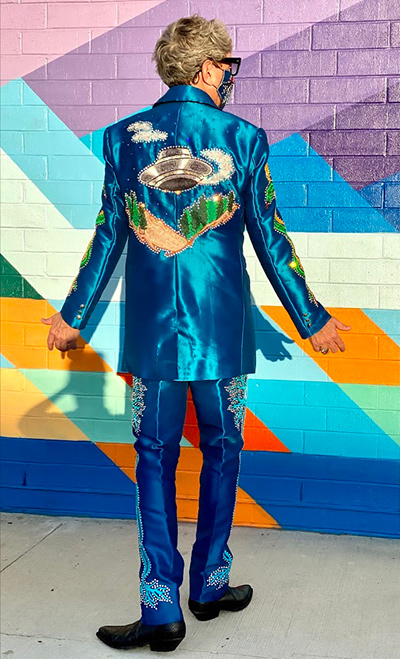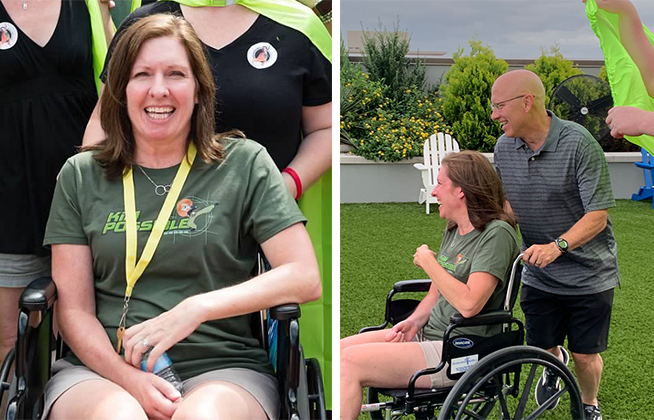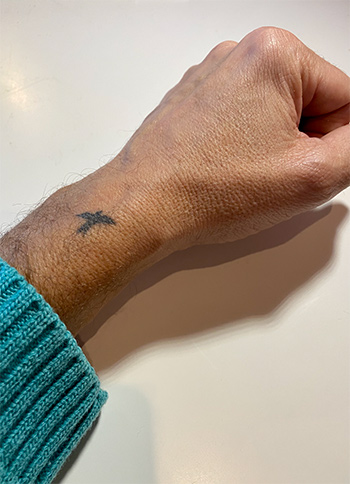
A Bold Approach to Caring for ALS Patients
Rick Bedlack, MD, PhD, is easy to spot from a distance. Instead of a white coat, the Duke neurologist wears distinct outfits when seeing patients at the Morreene Road Neurology Clinic in Durham, NC. A black leather jacket with mirrored studs and matching tie, burgundy crushed velvet suit and bow tie, a Hawaiian shirt festooned with Chinese dragons, or a pink, yellow, and green sweater vest with a Donald Duck pattern across his midsection are some of the dozens of entries in his growing wardrobe.
These outfits are more than just a fashion statement. For the past 25 years, Bedlack has specialized in treating patients with amyotrophic lateral sclerosis (ALS), an incurable neuromuscular condition that gradually destroys a person’s ability to move, speak, and breathe. Each outfit Bedlack wears is calculated to disarm patients who might be nervous, open a topic of conversation, or make at least one element of a medical visit enjoyable for both him and his patients.
“ALS is a terrifying disease,” said Bedlack. “If I can give patients a little something to look forward to with a fun outfit, then maybe the first thing they will think about is what Dr. Bedlack has on today, or ‘what an outrageous outfit’, or ‘can I get a selfie with him,’ which will make things a little easier.”
Bedlack has been riveted by ALS since he saw his first patient who would later be diagnosed with the disease. It was 1996, and Bedlack was a medical resident at Duke at the time. While giving a neurological exam—a basic assessment of a patient’s mental status, balance, and reflexes—he saw patterns that he hadn’t seen before. “There’s no physical exam like the exam of a person with ALS. I remember thinking that ALS is such a fascinating disease, and then being completely horrified when the attending physician came in and said, ‘We don’t know what causes this and there’s nothing we can do about it,’” Bedlack said.

Since then, care for ALS patients has evolved into a team effort. Today, Duke’s ALS clinic consists of 17 specialists, including neurologists like Bedlack, as well as physical, occupational, and respiratory therapists, dietitians, social workers, and speech pathologists – all who work together with patients as a team to help them preserve as much movement as possible, avoid pain and discomfort, and adjust their routines and home arrangements to live as comfortable and independent a life as possible.
While the quality of life for many ALS patients has improved over the last few decades, there are still no medications or therapies that can halt or significantly slow the progress of the condition. While the rate of disease progression varies, the average life expectancy of a person with ALS is two to five years.
Bedlack has seen his patients face ALS with extraordinary bravery, compassion, and hope, but he’s has also seen them grow frustrated with their limited treatment options. Clinical trials to test new therapies for ALS are often frustrating for patients with the condition. The first barrier is time. People with ALS simply don’t have enough of it. Clinical trials can take years from the time the studies are launched until the time results are ready to share. Placebos—inactive substances given in place of the therapy being tested—improve the reliability of a trial, but many people with ALS balk at taking a medication with no effect during the last remaining months of their lives. Physical access is also an issue. ALS limits patients’ ability to walk, eat, or perform other daily tasks, so going to a clinic for regular evaluations can be incredibly difficult for ALS patients. The COVID-19 pandemic has only exacerbated these challenges for patients.
With the lack of validated therapies, many patients turn to what Bedlack refers to as the “wild West” of alternative therapies for ALS. These alternative therapies include probiotics, vitamins, stem cell injections, acupuncture, “chelation therapy” to remove heavy metals from the body, herbal supplements, and more. Word of mouth, social media, or the Internet may tout these alternative therapies as “guaranteed” or “medically proven” ways to beat ALS. The evidence for these therapies is anecdotal at best. Most of these treatments may raise people’s hopes (and empty their wallets) while having no effect on ALS. In other cases, these alternative therapies may actually be harmful or deadly to the people taking them.
A few alternative therapies may show potential benefit for individuals with ALS, but a skeptical approach and a scientific body of evidence are needed to separate any alternative therapies that might help from the ones that don’t, Bedlack said.

In hopes of discovering scientifically proven treatments for ALS, Bedlack is applying the same bold, unconventional, and patient-centric approach he has used to build his distinctive wardrobe. In August 2020, he opened his second in a series of pilot clinical trials called Replication of ALS Reversals (ROAR). The first ROAR trial examined Lunasin, a peptide found in soybeans; the second ROAR trial is examining theracumin, an easily absorbable form of curcumin.
Bedlack has set two strict criteria for his ROAR trials. First, the potential therapy must have a scientifically plausible mechanism by which it might slow the progression of ALS. Curcumin for example, can decrease inflammation, oxidative stress, and protein aggregation, and can alter the microbiome (the family of bacteria living in the gut). Second, the candidate must be associated with an existing case of an ALS reversal. ALS reversals are rare but there have been verified cases where the progression of ALS froze or reversed for several months or more. Curcumin or theracumin have been associated with six documented ALS reversals, Bedlack says.
Bedlack has also modeled the ROAR trials to meet the needs and preferences of the ALS patients he has known over the years. ROAR trials use historic controls rather than placebos, ensuring that all participants receive the treatment being tested. ROAR trials eliminate the need for visiting a clinic: patients periodically measure the progression of ALS and are evaluated through telemedicine instead. The results of ROAR trials are available in real time; patients do not have to wait years for them.
One of Bedlack’s patients navigating the challenges of living with ALS is Kim Blair, 51, a former realtor living in Durham. Blair first noticed her symptoms in December 2019, when she kept dropping her pen while writing her Christmas cards. “My hand kept cramping up, and I felt a weakness in my thumb and forefinger. I just thought it was because I had already written a bunch of notes for the holidays,” Blair said in an interview in October. Soon after, her training for a half-marathon became increasingly difficult and painful. Her primary care provider referred Blair to a neurologist. After several visits and tests, Blair was diagnosed with ALS and began seeing Bedlack last April.
Since her diagnosis, ALS has gradually taken over a larger role in Blair’s life. Walking became more difficult, and then impossible, so Blair transitioned to a walker and then a wheelchair. Formerly simple tasks like taking a shower required planning, help from her husband, and considerable effort.
“With ALS, there’s so little I can do on my own, and even the things I can do all make me really tired. I used to be a very active person and now I’m mostly sedentary. ALS is a horrible disease,” Blair said in an interview this fall. Since then, Blair has become almost completely paralyzed by ALS. She and her husband recently moved to a new home where she can live her remaining days as comfortably and peacefully as possible.

Guided by Bedlack, Blair took curcumin as well as clenbuterol, an asthma medication, in an attempt to stimulate growth of her atrophying muscles for most of 2020. Blair hopes her participation will help guide other individuals living with ALS.
Blair has also adapted by practicing gratitude for the joys in her life: her friends, her faith, and most of all her husband Brett. “My husband and I early on decided to live in the present--one day at a time,” Blair said. “That helps. We could easily spiral into ‘what if’s’ and ‘what’s nexts.’ We don’t want to spoil today with the fear of tomorrow. We try to have a filter of only doing things that bring us joy.”
Learning about the personal lives of his patients is important to Bedlack. He is committed to meeting each new patient and investigating each new potential therapy with joy and resilience. In addition to his flashy wardrobe, one reminder of Bedlack’s commitment to his patients and fighting this disease never changes: a tattoo of a swallow on his left wrist.

The small black tattoo is in memory of Tim, a 29-year-old patient Bedlack saw a few years after he began seeing patients at Duke. Tim and his circle of family and loved ones all decided to get tattoos of swallows to unite them as a group dedicated to helping Tim. They came to clinic as a unit, helped him make videos to teach people about ALS, and make lifestyle adjustments to cope with his progressing condition. Bedlack got his own swallow tattoo. Tim maintained a positive attitude even as his condition worsened and he eventually succumbed to the disease in 2011.
“I am left-handed and my swallow is on my left wrist. Each time I sign a chart, my tattoo pops out of my sleeve. It reminds me of Tim and reminds me that I have more powerful weapons to offer against ALS than medications and equipment; I am now always careful to say something funny, optimistic, and or hopeful to my patients,” Bedlack said.
Will Alexander is Director of Communications for the Department of Neurology in the Duke University School of Medicine. Photos of the Blairs provided by the Blair family. Photos of Rick Bedlack by Maddy Gray.
